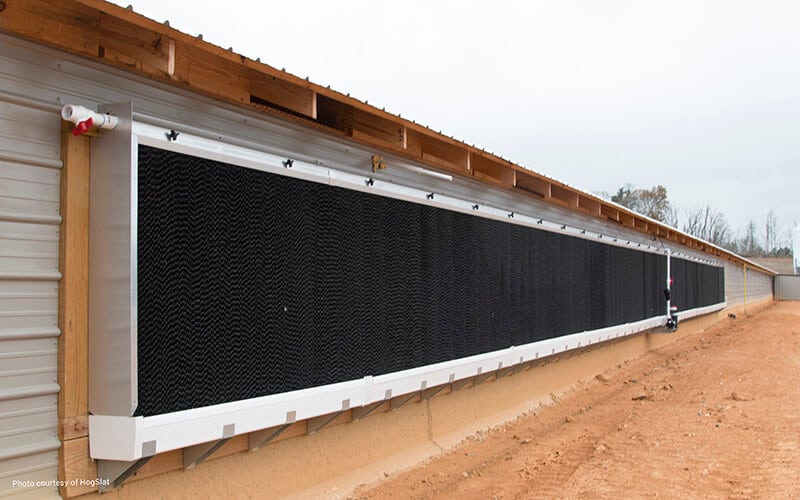
Sow farms struggling to breed and farrow during hot, humid weather can pick up some tips from North Carolina, where this type of weather hangs around a long time.
“We have a big corner on heat and humidity with 40 to 45 days with the heat index above 100°,” reported Cary Sexton, DVM, veterinarian with Four Star Veterinary Service in Kinston, North Carolina. “We definitely have to employ sow-cooling strategies.”
After many years of experience, he has seen what works best to keep sows productive through hot weather.
Cooling sow in farrowing
The top of the line for cooling sows in farrowing are cool cells, according to Sexton. Compared to drippers, which are the next best option, cells aren’t as likely to plug and do not drip water on the pigs.
“The problem is cool cells affect ventilation efficiency and restrict air flow,” he said. “Some farms have gone in and put in drippers with the cool cells as an additional stage. The cool cells should stage in after the last fans are running.
“If the temperature continues to rise, the drippers will turn on to get a small portion of each sow wet and then shut off, leading to a more local evaporative cooling effect. But it all needs to be timed.”
Drippers in farrowing must be monitored because excess moisture can cause shoulder sores. Sexton recommends positioning a dripper between the sow’s ears and shoulders to prevent udder or shoulder problems. The extra moisture from drippers can also lead to diarrhea in piglets.
But overall, cool cells with timed drippers work. “We will see 90° to 95° in buildings on high-humidity days,” he said. “This is when drippers on the farrowing sows do a good job. We’ve seen how the sows’ respiratory patterns decrease with the drippers and cool cells running in tandem, and we don’t see as dramatic a drop in lactation feed intake.”
Focus on sow condition
Most gestation units among Sexton’s clients already use intensive management to keep sows in good condition. But some units have experienced problems getting the sows bred back during and following the hottest parts of the summer.
“In previous summers, some units had increased wean-to-first-service intervals because the sows wouldn’t eat in lactation,” Sexton explained. “So, we now put more effort into sow conditioning in the months leading into summer.”
Starting in the spring, sow farms focus on getting sows in proper condition to handle the hottest parts of the summer.
“We use a body-condition sow caliper to consistently evaluate body condition and feed the amount needed to achieve a condition score of 3 in a 30- to 60-day time period,” he explained.
“We have more problems with heavier sows. These sows have more insulation and hold more of their heat in the summer, in combination with the fact that their body temperature goes up as they eat.”
Feeding strategies
Lactation feed-time strategies help. “Get the sows fed early in the morning and fed last in the afternoon so they are eating during cooler times are top priorities,” he said.
This feed regimen is also practiced on farms that utilize automatic feed systems in farrowing. These farms also drop additional feed to sows that have cleaned up since their last feeding when employees walk through the rooms, Sexton explained. These same farms also offer smaller, more frequent meals up to five times a day.
The automatic feed technology also allows the sows to be fed consistently, even on weekends which also is a huge advantage due to labor availability on weekend shifts, he added.
Room temperatures in gestation and farrowing will affect how sows eat. Sexton recommends setting the temperatures to favor the sow’s comfort. Heat lamps or pads provide supplemental, zone heating to warm piglets without affecting the sows. These items must be removed as soon as piglets can maintain their own body temperatures.
He suggests tying these heat sources into the ventilation system to allow adjustment to weather events like an afternoon thunderstorm, which dramatically changes the temperature profile of farrowing rooms.
“Without connecting heat to ventilation, the heat source may not return to full power and respond to the pigs’ need for supplemental heat, leading to increased piglet mortality or illness,” Sexton added.
Be attentive to sows
Overall, the best strategy is to “be very attentive to your sows,” Sexton concluded. “When you have things occur, ask yourself what strategies and technology do I have available for the overall comfort of that sow? And remember for sows not acclimated to the heat and humidity, hot and humid weather can be as tough if not tougher on them than the workers.”
